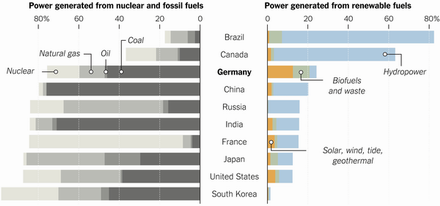
|
|

|
|
| April 19, 2024 |
|
Sun and wind alter global landscape, leaving utilities behind 
HELIGOLAND, Germany — Of all the developed nations, few have pushed harder than Germany to find a solution to global warming. And towering symbols of that drive are appearing in the middle of the North Sea.
They are wind turbines, standing as far as 60 miles from the mainland, stretching as high as 60-story buildings and costing up to $30 million apiece. On some of these giant machines, a single blade roughly equals the wingspan of the largest airliner in the sky, the Airbus A380. By year’s end, scores of new turbines will be sending low-emission electricity to German cities hundreds of miles to the south. It will be another milestone in Germany’s costly attempt to remake its electricity system, an ambitious project that has already produced striking results: Germans will soon be getting 30 percent of their power from renewable energy sources. Many smaller countries are beating that, but Germany is by far the largest industrial power to reach that level in the modern era. It is more than twice the percentage in the United States. Germany’s relentless push into renewable energy has implications far beyond its shores. By creating huge demand for wind turbines and especially for solar panels, it has helped lure big Chinese manufacturers into the market, and that combination is driving down costs faster than almost anyone thought possible just a few years ago. Electric utility executives all over the world are watching nervously as technologies they once dismissed as irrelevant begin to threaten their long-established business plans. Fights are erupting across the United States over the future rules for renewable power. Many poor countries, once intent on building coal-fired power plants to bring electricity to their people, are discussing whether they might leapfrog the fossil age and build clean grids from the outset. A reckoning is at hand, and nowhere is that clearer than in Germany. Even as the country sets records nearly every month for renewable power production, the changes have devastated its utility companies, whose profits from power generation have collapsed. A similar pattern may well play out in other countries that are pursuing ambitious plans for renewable energy. Some American states, impatient with legislative gridlock in Washington, have set aggressive goals of their own, aiming for 20 or 30 percent renewable energy as soon as 2020. The word the Germans use for their plan is starting to make its way into conversations elsewhere: energiewende, the energy transition. Worldwide, Germany is being held up as a model, cited by environmental activists as proof that a transformation of the global energy system is possible. But it is becoming clear that the transformation, if plausible, will be wrenching. Some experts say the electricity business is entering a period of turmoil beyond anything in its 130-year history, a disruption potentially as great as those that have remade the airlines, the music industry and the telephone business. Taking full advantage of the possibilities may require scrapping the old rules of electricity markets and starting over, industry observers say — perhaps with techniques like paying utilities extra to keep conventional power plants on standby for times when the wind is not blowing and the sun is not shining. The German government has acknowledged the need for new rules, though it has yet to figure out what they should be. A handful of American states are beginning a similar reconsideration of how their electric systems operate. “It’s pretty amazing what’s happening, really,” said Gerard Reid, an Irish financier working in Berlin on German energy projects. “The Germans call it a transformation, but to me it’s a revolution.” The potential payoff for getting the new rules right is enormous: a far greener electricity system that does not pump as much greenhouse gas and other pollution into the atmosphere. Yet as the German experience shows, the difficulties of the transition are likely to be enormous, too, and it is still far from clear whether the system can be transformed fast enough to head off dangerous levels of global warming. “I am convinced that wind and sun will be the central sources of energy, not only in Germany but worldwide,” said Patrick Graichen, who heads a think tank in Berlin, Agora Energiewende, devoted to studying the shift. “The question is: How can we turn the energy transition into a success story?” (Source: New York Times) Story Date: September 15, 2014
|